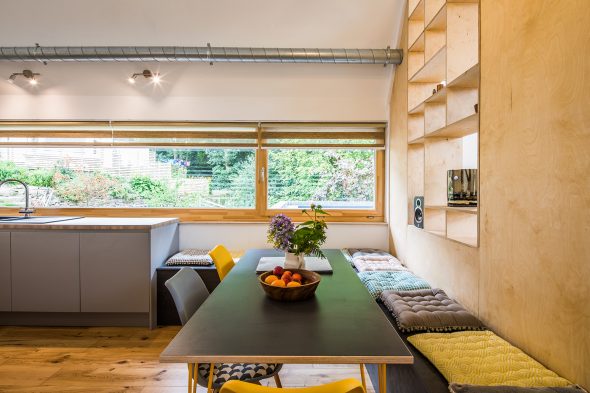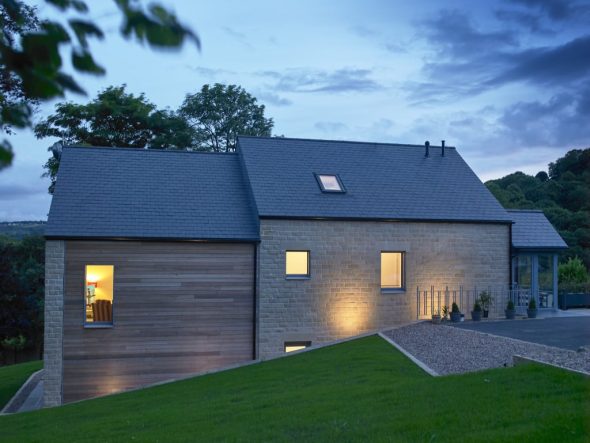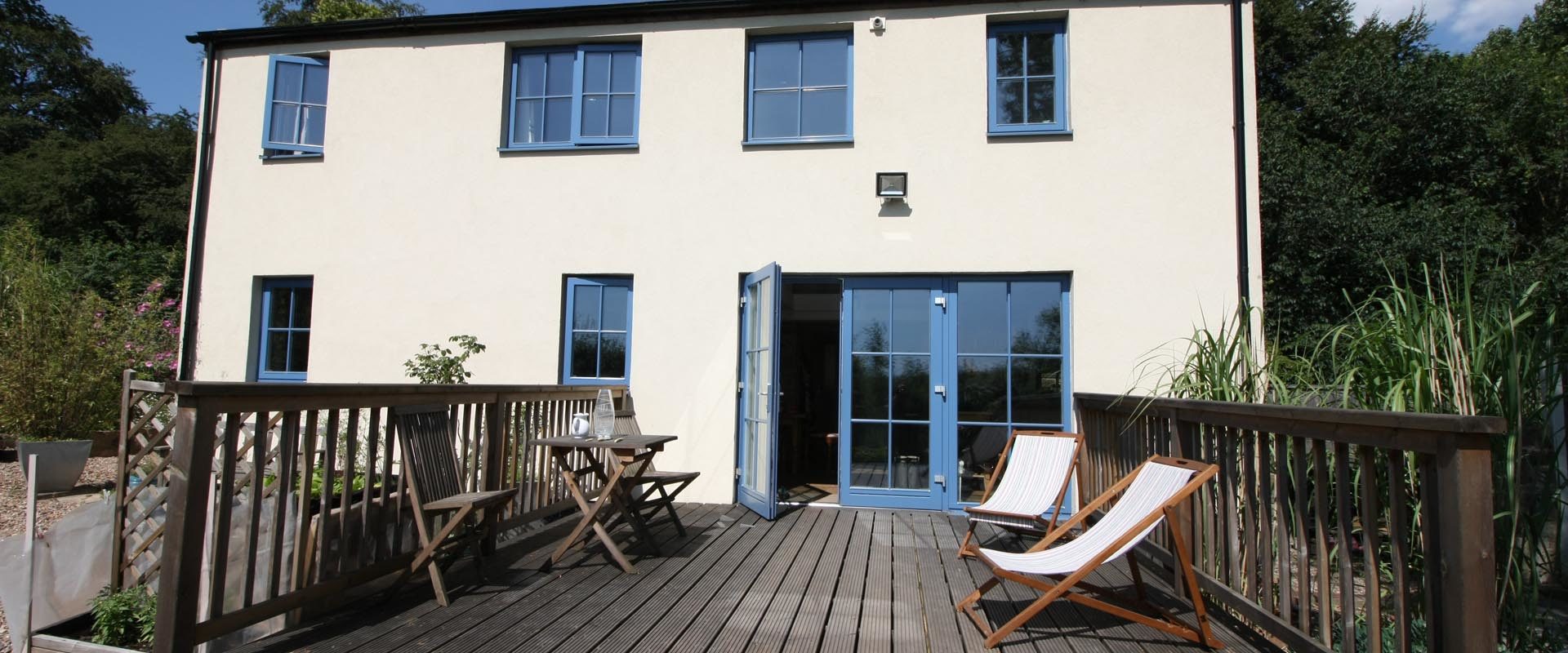We have teamed up with Green Building Store to help you choose the best windows and doors for your home.
We have used products from Green Building Store on many projects, and with over 20 years’ experience of working on low energy homes and buildings, they are the go-to specialists in airtightness and insulation, windows, doors and advanced MVHR products.
Without further ado, let’s introduce you to Green Building Store Director Chris Herring who shares his tricks of the trade.
Balancing performance and budget on your self-build project
New windows and doors can be a significant part of the budget of your self-build, new build or retrofit. However, there are ways to keeping costs down, while ensuring good quality and thermal performance (U Value).
What is U Value?
This is a term we use to describe the thermal performance (glass & frame) of a window or door. The calculated value indicates the heat loss and is measured in W/m2K. The lower the U value, the better the thermal performance.

Simple design
It may seem obvious, but the simpler the window design the lower the cost will be. More complex windows (with additional mullions or multiple opening sections) significantly increase the cost, while simultaneously making the performance worse. For example, a simple opening window (sized 1200mm X 1480mm) could be half the price of the same sized window with two openings and glazing bars.
At the same time, the thermal performance of these more complex designs will be worse than a window with a simple form, for example, a single opener. So the U value of the more complicated window could be up to around 50% worse while costing much more. Fixed windows are of course, cheaper again. In new low energy and Passivhaus homes, the need to have every window as an opening window is reduced, due to the use of mechanical ventilation systems (MVHR).
Similarly with doors, while fold-aside doors are undeniably popular for the clear opening they offer, double doors with fixed sidelights (in an opening of 3500mm) can come in at about half the cost as well as being a little more energy-efficient. Even with double doors, you can end up with a clear opening of two metres, so why not consider these and save some money? This is what Paul has done on his own retrofit project.

Reducing safety glazing costs
We would never advocate skimping on health and safety when choosing windows and doors, but big savings can be made through simple design changes.
Top tip
You can save a considerable amount of money by designing out the need for toughened safety glass by setting the windows higher up in a room. For example, setting windows with glazing above 800mm from the floor level could reduce costs by around 40-50%.
Good installation matters
Where and how the windows and doors are installed has a big impact on their performance and cost-effectiveness. And this means real heat loss, so it does matter.
In the UK we don’t usually consider the issue of thermal bridges around the edges of windows properly. Fortunately, the Passivhaus methodology does.
Careful detailing of window installation will pay dividends in the long run. Positioning the window within the insulation layer, with careful attention to the detail can make a very big difference to the installed U value of the window. It’s something we take account of in Passivhaus methodology but not currently in conventional UK building.

Value for money
So, putting this together, if we take into account the loss of performance from more complex window configurations, and poor thermal detailing, we can make a massive difference to our window performance while ensuring much better value for our money.
Let’s look at an example of a good triple glazed opening window. It is 1200 x 1200 mm, with a Uw value of 0.85 W/m2K.
Well installed, the installed U value can be… 0.85 W/m2K!
Now if we make the same sized window with mullions and small openers, and install it badly, the installed U value is…. 1.8 W/m2K!
That’s a massive 112% loss of performance from a more expensive window.
It’s your choice of course, but consider the design carefully and ensure good installation details (and good airtightness!) and you can save a lot of money while being more comfortable and more energy efficient.
Sometimes paying more for windows can save you money
If you look at the overall costs of ultra-low energy Passivhaus projects there are many instances where a higher specification, more expensive, window, with better U values and installation thermal bridge (psi) values, can improve performance and save money.
This is because we can offset the better window performance against other building fabric details, and still achieve our 15 kWh/m2/ year Passivhaus target.
Golcar Passivhaus project
At our Golcar Passivhaus project, we used a higher specification PROGRESSION window (with a U value of 0.68 W/m2K). Modelling this in in PHPP (Passivhaus Planning Package) we found that specifying the PROGRESSION windows affected the overall space heating demand of the project by 1.7 kWh/m2/ year compared to our cheaper ULTRA Passivhaus suitable window.
This meant that, if we had wanted to, we could have altered the specification for insulation in the cavity from 300 mm to 240 mm while still achieving Passivhaus standards of performance.
The cost of insulation savings could have potentially surpassed the additional costs of the higher specification PROGRESSION windows.
The various options need to be carefully costed and explored – this is one of the advantages of using PHPP as a planning and design tool.

Vigilance with quotes
Lastly, when getting quotes for windows and doors it’s important to check that you are comparing like with like. Otherwise, it is all too easy to get a nasty surprise further down the line.
It is also important that window and door suppliers take building regulation requirements into account when quoting. Unfortunately, our experience is that they often don’t. So, it’s important to know if the windows and doors quoted comply with building regulations such as:
- Part Q (security)
- Part B (means of escape)
- Part M (means of access)
- And Part F (ventilation) etc?
Top tip
To avoid additional costs cropping up, make sure that you send enough information when requesting a quote.
Key points
So, in summary, here are some key questions to ask when choosing windows & doors for your new build or retrofit project:
- Can I simplify or optimise my window choices for best value and performance?
- Can I ensure the best value from my windows and doors, by installing well and reducing thermal bridges?
- If working on a Passivhaus, can I choose a higher specification window to achieve insulation cost savings elsewhere?
- Can I ensure when I compare quotes that I am on a ‘level playing field’?
- Can I design out costly elements like safety glass or other specialist glass?
- Do the 10-metre sliding doors really add value for me?
Chris Herring, Director, Green Building Store
Further reading
Watch a FREE webinar for more information: https://www.greenbuildingstore.co.uk/webinar-value-engineering-windows-ways-to-keep-costs-down/
See an overview of Green Building Store’s triple glazed timber windows & doors: https://www.greenbuildingstore.co.uk/triple-glazed-timber-windows-doors/
To get a quote for triple glazed windows & doors visit: https://www.greenbuildingstore.co.uk/free-window-door-quote/

